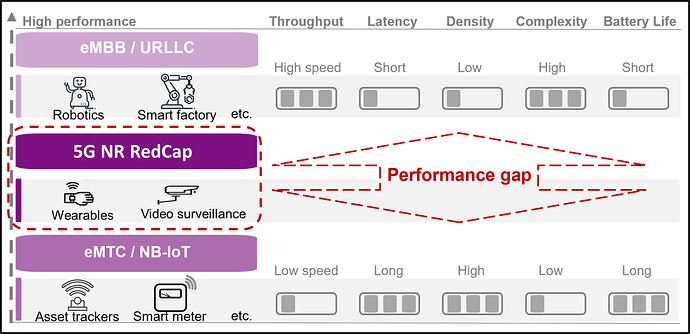-
My friend: Hi Ibrahim, I have a question for you.
- Me: You are most welcome, go ahead.
-
My friend: I am hearing a lot about the NR RedCap but don’t understand what is it exactly, could you please help here?
- Me: Sure, NR RedCap (New Radio Reduced Capability) is a feature that is introduced by 3GPP in Rel.17, it was also know previously as NR-Lite and then NR-Light before agreeing on NR RedCap at the end. In my opinion, it is a very intelligent feature as the idea here is that 5G technology has very high capabilities such as high throughput& low latency and hence normal 5G devices should support a lot of features to enjoy these capabilities such as high transmit and receive BW, high supported number of receive antenna branches and DL MIMO layers, high DL modulation order, but there are many use cases that don’t require all these high 5G capabilities and hence why not to reduce the capabilities of the devices used in these use cases to make them cheaper and hence we have a very cost efficient solution that will help to expand the NR device ecosystem and increase the no. of the 5G use cases as well.
-
My friend: But what are these use cases that don’t require the high capabilities of 5G?
- Me: The use cases that motivate the specification work on NR RedCap include wearables (e.g. smart watches, wearable medical devices, AR/VR goggles, etc.), industrial wireless sensors, and video surveillance as outlined by 3GPP. You can notice that these use cases have less stringent data rate requirements than eMBB use cases, and do not require tight latency requirement as time-critical communications use cases. Therefore, NR RedCap acts as a bridge between support for low complexity and high-performance use cases. But take care as these devices have higher capabilities than NB-IoT and LTE-M, to bring ‘middle of the range’ devices.
-
My friend: So, which techniques are used to make these devices with reduced capability?
- Me: Many things such as supporting max BW of 20MHz in FR1 and 100MHz in FR2, max no. of MIMO layers is 1 or 2, max DL modulation order is 64QAM, supporting HD-FDD (half-duplex FDD), so device can’t transmit and receive at the same time. Furthermore, a RedCap device is expected to operate in a single band at a time and will not support carrier aggregation and dual connectivity. So, using this approach, we’ll have less complex device which is also less costly.
-
My friend: Thank you very much, you made it very clear.
- Me: You are most welcome.
LinkedIn: ![]()
